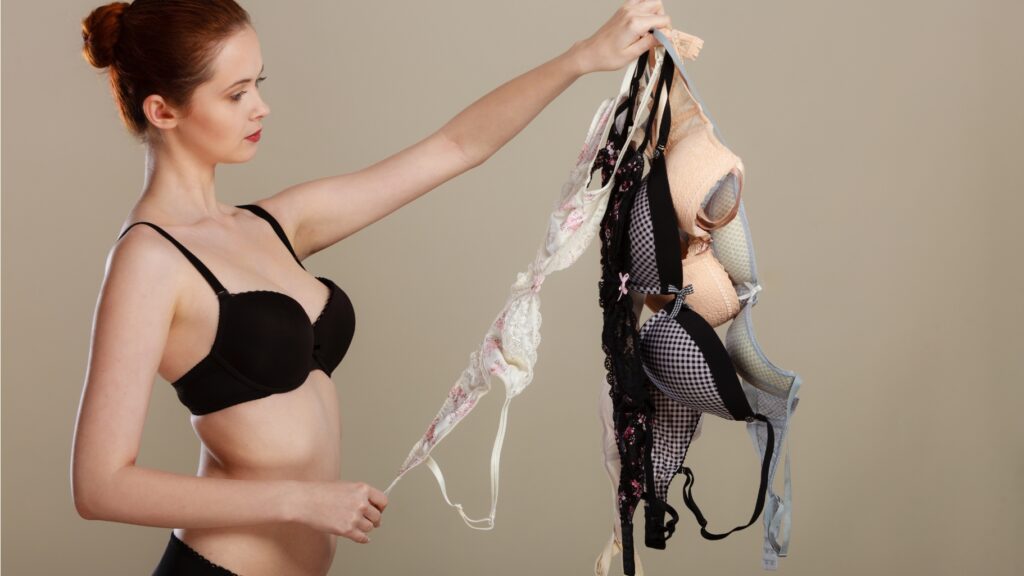Women Bra Facts and Myths – Right Ways to Wear Bra

The practice of wearing bras by women is deeply rooted in cultural, societal, and health considerations. Beyond being a fashion accessory, bras serve as a crucial undergarment designed to provide support and protection to the breasts that depends entirely on the right ways to wear bra. From a health perspective, bras help reduce the strain on breast ligaments, minimizing discomfort and potential sagging. Properly fitted bras contribute to maintaining the structural integrity of the breasts, especially during physical activities. Additionally, bras offer a sense of modesty and conform to societal norms of attire. The choice to wear a bra can also be a personal preference, influenced by comfort and individual body confidence. While cultural and fashion trends may shape the variety of bras available, the underlying significance lies in the practical and health-related support they offer to women in their daily lives.
Contents
ToggleWomen Bra Amazing Facts
Women who know the world about all sorts of bra, still skip few facts about these micro clothing. Here are some interesting and lesser-known facts about women’s bras:
- Invention Dating Back: The concept of bras can be traced back to ancient civilizations, but the modern brassiere was patented in 1914 by Mary Phelps Jacob.
- Bra Sizing Complexity: Determining the right bra size is more intricate than just measuring band and cup size. Factors like breast shape, tissue density, and personal comfort also play a crucial role.
- Evolution of Sports Bras: The sports bra, initially called the “jockbra,” was invented in 1977 by Lisa Lindahl, Polly Smith, and Hinda Miller, aiming to provide better support during exercise.
- Bras and Fashion Trends: Bras have evolved with fashion trends. From cone-shaped bras in the 1950s to the push-up bras of the 1990s, they reflect changing ideals of beauty.
- The Most Expensive Bra: The world’s most expensive bra is the “Victoria’s Secret Fantasy Bra,” valued at millions of dollars. It is adorned with precious gemstones.
- Bra Burning Myth: The notion of feminists burning bras as a symbol of liberation is a myth. While feminists protested various issues in the 1960s, bra burning wasn’t a widespread occurrence.
- Bra Comfort Experiment: In 2013, a Japanese lingerie company introduced the “Rice Bra,” claiming to enhance comfort by using rice-filled pouches instead of underwire.
- Fastening Front and Back: Most bras fasten at the back, but some models, especially sports bras, have front fastenings for convenience.
- Bra Design Innovations: Continuous innovations include moisture-wicking bras for athletes, self-adhesive bras for backless dresses, and maternity bras designed for breastfeeding.
- Bra Recycling Programs: Some companies have initiated bra recycling programs, turning old bras into materials for insulation or creating new products.
- The Impact of Celebrities: Celebrities often influence bra trends. For instance, after Madonna popularized the cone-shaped bra, it became a fashion statement.
- Bras and Self-Expression: Bras are not just undergarments; they can be a form of self-expression. Unique designs, colors, and patterns allow women to showcase their personal style.
These fascinating facts showcase the diverse history, functionality, and cultural significance of women’s bras.
Women Bra Myths
Several myths and misconceptions surround the topic of women’s bras. Let’s debunk some of these common myths:
- Myth: Wearing a Bra Prevents Sagging:
Reality: While a well-fitted bra can provide temporary lift and support, it doesn’t prevent breast sagging. Factors like aging, genetics, and pregnancy play a more significant role.
- Myth: Sleeping in a Bra Keeps Breasts Perky:
Reality: There’s no evidence that wearing a bra while sleeping prevents sagging. In fact, it’s advisable to let breasts breathe during the night for comfort.
- Myth: Underwire Bras Cause Breast Cancer:
Reality: Scientific studies have not found a link between wearing underwire bras and an increased risk of breast cancer. The myth is unfounded. Rather, the right way to wear a bra, especially an underwire bra is the underwire should surround the whole under part of the breast and never press against the breast tissue at the side or in the middle.
- Myth: Bras Should Last a Lifetime:
Reality: Bras, like any garment, have a lifespan. The elastic and fabric wear out over time, affecting support. Regularly updating bras is essential for comfort and functionality.
- Myth: All Bras Fit the Same Way:
Reality: Bra sizing varies among brands and styles. A woman may wear different sizes depending on the design and brand, highlighting the importance of proper fittings.
- Myth: Push-Up Bras Increase Breast Size:
Reality: Push-up bras enhance cleavage and create the illusion of fuller breasts, but they don’t permanently increase breast size.
- Myth: Bra Size Never Changes:
Reality: Factors like weight fluctuations, pregnancy, and aging can impact breast size. Regularly checking and updating one’s bra size is crucial for comfort.
Recommended: Bra Tips: Understanding Cup Size vs. Band Size
- Myth: Bra Straps Should Always Dig In:
Reality: Straps digging into shoulders indicate an ill-fitted bra. Well-designed bras distribute weight evenly for comfort without causing indentations.
- Myth: All Bras Are Uncomfortable:
Reality: A properly fitted bra should not be uncomfortable. Discomfort often results from wearing the wrong size or style.
- Myth: Underwire Bras Are Always Uncomfortable:
Reality: Underwire bras, when correctly fitted, can provide excellent support without discomfort. It’s crucial to find the right size and style.
- Myth: Bras Make Breasts Weaker:
Reality: Wearing bras doesn’t weaken breast tissue. In fact, a well-fitted bra can provide support during physical activities and reduce discomfort.
- Myth: Sports Bras Are Only for Sports:
Reality: Sports bras offer superior support during physical activities, but they are also comfortable for everyday wear, especially for women with active lifestyles.
Understanding the reality behind these myths is essential for choosing the right bras and promoting breast health and comfort.
Advantages of Wearing Bra
Wearing a bra serves various practical, health-related, and comfort purposes, contributing to several advantages for women. Here are some of the key advantages:
- Breast Support: The primary function of a bra is to provide support to the breasts, helping to distribute their weight and reduce strain on the ligaments. This is especially important during physical activities or for women with larger breasts.
- Enhanced Comfort: A well-fitted bra can enhance overall comfort by preventing breast movement, minimizing friction between the breasts and clothing, and providing a sense of security and stability.
- Posture Support: Bras can contribute to better posture by providing support to the breasts and the upper body. This is particularly beneficial for women with larger breasts, as it helps distribute weight more evenly.
- Preventing Sagging: While not a foolproof method, wearing a bra can offer temporary lift and support, potentially reducing the risk of breast sagging over time, especially during activities that cause breast movement.
- Reducing Discomfort During Physical Activity: Sports bras, specifically designed for physical activities, minimize breast movement and discomfort during exercises, making workouts more manageable and enjoyable.
- Enhanced Clothing Fit: Wearing a bra can improve the fit of clothing, ensuring that garments hang properly and provide a more flattering silhouette.
- Nipple Coverage: Bras offer nipple coverage, providing modesty and preventing nipples from showing through clothing, which can be desirable in certain social or professional settings.
- Psychological Comfort: For many women, wearing a bra provides a sense of psychological comfort and confidence. It can be a personal choice linked to cultural norms, fashion preferences, or individual comfort levels.
- Reduced Breast Pain: Wearing supportive bras can help alleviate breast pain and discomfort, especially for women experiencing conditions like mastalgia (breast pain) or during hormonal changes, which is clearly the right way to wear a bra.
- Maintaining Breast Shape: Wearing a bra can help maintain the shape of the breasts, particularly during activities that cause breast movement. This can contribute to a more youthful appearance over time.
- Adaptable to Lifestyle: Bras come in various styles, including sports bras, push-up bras, and everyday bras, catering to different lifestyles, activities, and fashion preferences.
- Post-Surgery Support: Women who have undergone breast surgery, such as augmentation or reduction, often benefit from wearing supportive bras during the recovery period to aid healing and provide comfort.
While some women may choose not to wear bras for personal reasons, these advantages highlight the functional and health-related benefits that bras can offer to many individuals.
Disadvantages of Wearing Bra
While wearing a bra offers various benefits, some women may experience disadvantages or discomfort associated with regular bra use. It’s important to note that these experiences can vary from person to person, and individual preferences and body types play a significant role. Here are some potential disadvantages of wearing bras:
- Discomfort and Irritation: Ill-fitting bras or those made from materials that irritate the skin can cause discomfort, itching, or redness. Straps and underwire may dig into the skin, leading to irritation.
- Breathing Restrictions: Tight or restrictive bras may impact breathing, causing discomfort or a feeling of tightness around the chest.
- Impact on Lymphatic Circulation: Some argue that tight bras may hinder lymphatic circulation, potentially affecting the body’s natural detoxification process. However, scientific evidence supporting this claim is limited.
- Pressure on Shoulders: Bras with tight or narrow straps can put excessive pressure on the shoulders, leading to discomfort and, in some cases, contributing to shoulder pain.
- Breast Health Concerns: There is ongoing debate about whether bras, particularly those with underwire, may impact breast health. Some studies suggest a potential link to breast-related issues, but more research is needed for conclusive evidence.
- Difficulty Finding the Right Fit: Many women struggle to find bras that fit well, as sizing can vary among brands and styles. A poorly fitted bra may not provide adequate support and can contribute to discomfort.
- Impact on Breast Shape: Some argue that constant reliance on bras may weaken the natural supportive tissues of the breasts, potentially impacting their shape over time. However, scientific evidence supporting this claim is inconclusive.
- Circulation Issues: Tight bras, especially those with constricting bands, may impede blood circulation, potentially causing issues like skin indentations or numbness.
- Chafing and Heat: In warm climates or during physical activities, bras may contribute to chafing and trap heat, leading to discomfort and sweat accumulation.
- Sleep Discomfort: Some women find wearing a bra during sleep uncomfortable, and there’s no conclusive evidence supporting the idea that sleeping in a bra is necessary for breast health.
- Dependency on Bras: Regular bra use may create a dependency, making some women feel uncomfortable without wearing one. This psychological aspect can contribute to a perceived necessity rather than a personal choice.
It’s important to note that individual experiences vary, and some women may not encounter these issues. Additionally, choosing bras with proper sizing, comfortable materials, and styles that suit individual preferences can help mitigate potential disadvantages.
Right Ways to Wear a Bra
Wearing a bra correctly involves more than just putting it on; it’s essential to ensure the bra provides proper support and comfort. Here are the right ways to wear a bra:
- Get Professionally Fitted: Visit a lingerie store for a professional bra fitting. This ensures you know your correct size, which can change over time due to factors like weight fluctuations and aging.
- Check the Band Fit: The band of the bra should sit horizontally across your back, parallel to the ground. It should provide most of the support, so make sure it’s snug but not too tight. You should be able to fit two fingers under the band.
- Adjust the Straps: The shoulder straps should be adjusted to a length that offers support without digging into your shoulders. Straps that are too loose can lead to inadequate support.
- Center the Cups: The center gore (the piece of fabric between the cups) should lie flat against your sternum. If it lifts away, the cups may be too small.
- Ensure Cup Coverage: The cups should fully cover your breasts without any spillage. If your breasts are bulging over the top or sides, the cups are too small.
- Check Underwire Placement: If your bra has underwire, it should encase your breasts without digging into the sides or resting on breast tissue. The underwire should follow the natural curve of your breast.
- Hook the Bra Properly: Start by fastening your bra on the loosest hook. As the bra stretches over time, you can use the tighter hooks for a snug fit.
- Scoop and Swoop: After fastening the bra, lean forward and use your opposite hand to scoop each breast fully into the cup. This ensures all breast tissue is properly positioned.
- Check for Red Flags: Watch for signs of an ill-fitting bra, such as straps digging in, the band riding up, or discomfort. If you experience any of these issues, it may be time for a new bra or a different size.
- Rotate Bras: Avoid wearing the same bra every day. Rotate between different bras to allow them to rest between wears, helping to maintain their elasticity.
- Consider the Occasion: Choose the right style of bra for your outfit. Different bras are designed for various clothing styles, so consider the occasion and your wardrobe.
- Regularly Check for Size Changes: Factors like weight fluctuations, pregnancy, and aging can impact your bra size. Regularly check your size and get refitted when needed, which is one of the crucial factors for the right ways to wear a bra.
Remember that comfort is key, and finding the right bra may involve some trial and error. Regularly assessing your bra size and fit ensures you’re getting the support you need for your body.
Recommended For You
Common Concerns of Mothers in the Second Trimester
Priyadarshini Muduli
A full time passionate writer with imperishable determination to bring healthy, smart and pragmatic changes individually and socially. Concentrate especially on lifestyle, life and personal improvement, relationships, mental health and behavior, viral issues and literature based subjects.




